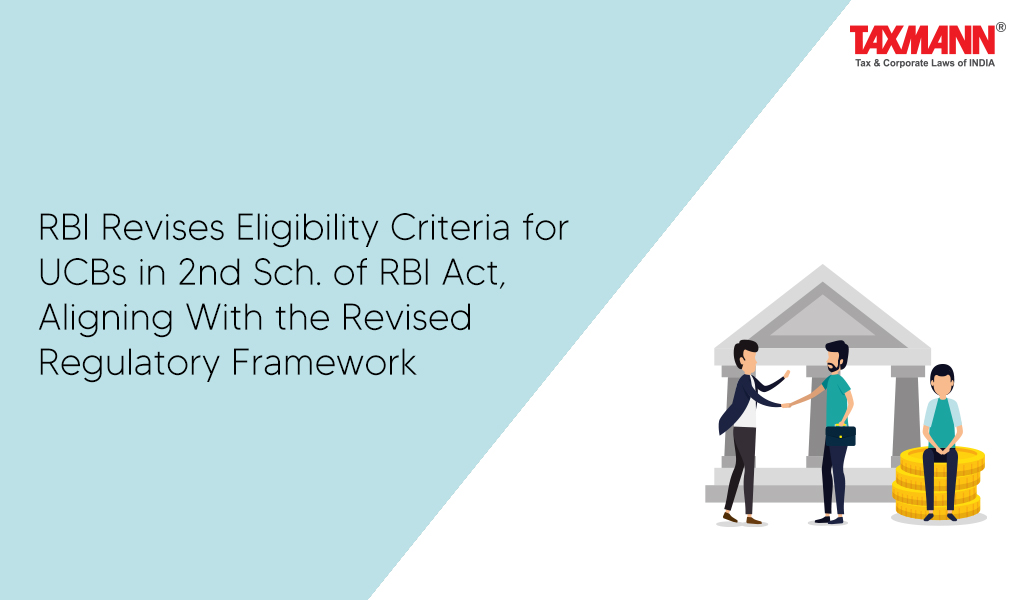RBI Revises Eligibility Criteria for UCBs in 2nd Sch. of RBI Act, Aligning With the Revised Regulatory Framework
- Blog|News|FEMA & Banking|
- 2 Min Read
- By Taxmann
- |
- Last Updated on 19 January, 2024

Circular No. RBI/2023-24/115 DoR.REG/LIC.No.72/16.05.000/2023-24, Dated 17.01.2024
After the release of the Revised Regulatory Framework for Urban Co-operative Banks (UCBs) on July 19, 2022, revised categorization norms for UCBs for regulatory purposes was notified and the criteria for classifying a UCB as Financially Sound and Well Managed (FSWM) have been revised. Now, the RBI has decided to revise the eligibility norms for inclusion of UCBs in the Second Schedule to the Reserve Bank of India Act, 1934 to bring them in conformity with the Revised Regulatory Framework.
In this regard, the Government of India vide notification dated Sep 04, 2023, has notified that the licensed Tier 3 and Tier 4 Primary (Urban) Co-operative Banks, fulfilling the criteria stipulated for Financially Sound and Well Managed Urban Co-operative Banks by the Reserve Bank of India.
Further, eligible UCBs satisfying the following criteria shall be considered for inclusion in the Second Schedule:
a) CRAR of at least 3 % more than the minimum CRAR requirement applicable to the UCB; and
b) No major regulatory and supervisory concerns.
The information mentioned above shall be based on the assessed financials and findings of RBI inspection report or audited financial statements, whichever is latest. Such eligible UCBs may submit their application for inclusion in the Second Schedule to the Reserve Bank of India Act, 1934 to the concerned Regional Office of the Department of Supervision of the Reserve Bank along with the following documents (two sets):
a) Copy of resolution passed by the Annual General Body/Board of Directors to make an application to RBI for inclusion in the Second Schedule to the Reserve Bank of India Act, 1934 and containing the name(s) of bank official(s) authorized to correspond with RBI in this regard; and
b) Major financial details of the bank together with copies of the published balance sheet for the last three years.
The revised instructions shall come into force from the date of issue of the circular i.e., 17.01.2024.
Click Here To Read The Full Circular
Disclaimer: The content/information published on the website is only for general information of the user and shall not be construed as legal advice. While the Taxmann has exercised reasonable efforts to ensure the veracity of information/content published, Taxmann shall be under no liability in any manner whatsoever for incorrect information, if any.

Taxmann Publications has a dedicated in-house Research & Editorial Team. This team consists of a team of Chartered Accountants, Company Secretaries, and Lawyers. This team works under the guidance and supervision of editor-in-chief Mr Rakesh Bhargava.
The Research and Editorial Team is responsible for developing reliable and accurate content for the readers. The team follows the six-sigma approach to achieve the benchmark of zero error in its publications and research platforms. The team ensures that the following publication guidelines are thoroughly followed while developing the content:
- The statutory material is obtained only from the authorized and reliable sources
- All the latest developments in the judicial and legislative fields are covered
- Prepare the analytical write-ups on current, controversial, and important issues to help the readers to understand the concept and its implications
- Every content published by Taxmann is complete, accurate and lucid
- All evidence-based statements are supported with proper reference to Section, Circular No., Notification No. or citations
- The golden rules of grammar, style and consistency are thoroughly followed
- Font and size that’s easy to read and remain consistent across all imprint and digital publications are applied



 CA | CS | CMA
CA | CS | CMA
